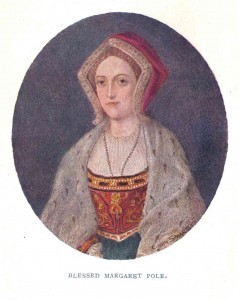There have been a few books published in the last few years about Blessed Margaret Pole, last princess of the royal house of Plantagenet. From The London Review of Books:
As the heir to the throne, Mary enjoyed a separate household, and in 1525 she was sent to Ludlow to hold court. The countess was to look after the little girl’s health and diet, ensure that she did not wear herself out in learning French and Latin, and see that her immediate environment was kept spotless, ‘so that everything about her be pure, sweet, clean and wholesome, as to so great a princess doth appertain’. Mary’s food, Henry ordered, was to be served with ‘joyous and merry communication’. Whether the countess was up to this is hard to say, but later the Imperial ambassador was to declare that Mary regarded her as ‘a second mother’. When Henry began proceedings to annul his first marriage, when Catherine was discarded and the Princess Mary downgraded to ‘Lady Mary, the king’s daughter’, Margaret proved fiercely loyal and protective. In an effort to force their co-operation, Henry separated his wife and child, and Margaret – who was Mary’s godmother – offered to serve the young girl at her own expense. She was no longer, though, the sort of influence Henry wished for his daughter. After his marriage to Anne Boleyn and the birth of their daughter, Elizabeth, Mary was sent to join the household of the infant princess. There, she was surrounded by connections of the Boleyn queen. Margaret was superfluous; curtly, Henry wrote her off as a fool. If he had trusted her once, he no longer did so. The prestige of her ancient family, her traditionalist stance in religion, and her status as a peer in her own right – all these defined a woman who might wish to resist the new order. And her gender did not necessarily disqualify her from becoming leader of the opposition – if that was what she chose. (Read more.)More HERE.
























No comments:
Post a Comment